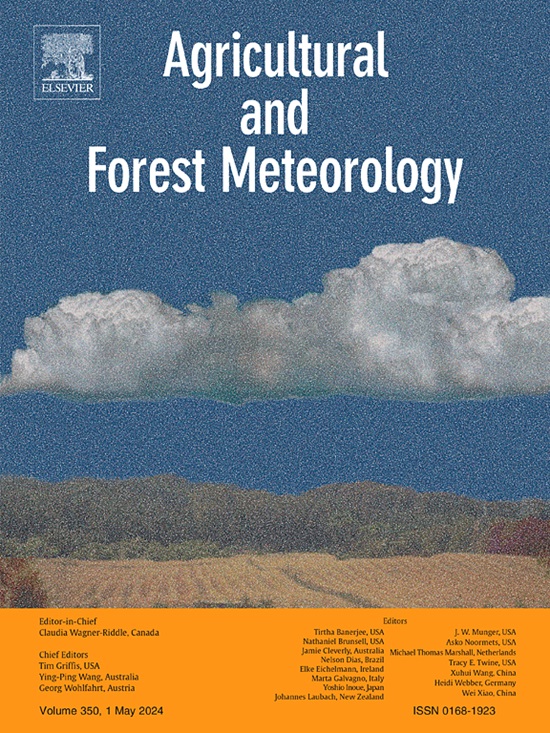Regionally variable responses of maize and soybean yield to rainfall events in China
IF 5.7
1区 农林科学
Q1 AGRONOMY
引用次数: 0
Abstract
Understanding crop yield responses to rainfall is essential for food systems adaptation under climate change. While there are ample evidences of crop yield responses to seasonal rainfall variation, the geographic sensitivities and driving mechanisms of sub-seasonal rainfall events remain elusive. We used long-term nationwide observations to explore the sensitivity of maize and soybean yields in response to event-based rainfall across Chinese agroecological regions. While maize and soybean yield showed concave downward responses to event-based rainfall depth at the national scale, these responses were differed considerably among regions. These differences can be primarily explained by soil moisture preceding rainfall events, soil erosion and sunshine hour reduction during rainfall. Our projections reveal that focusing on seasonal rainfall or national-level sensitivity analysis suggests a 0.3–5.9% increase in maize yields due to future rainfall, yet considering spatial variations unveils a contrasting reality, with maize yields declining by 9.1 ± 0.3% under a medium-range emission scenario (SSP2–4.5) by the end of century (2085–2100). The future rainfall effect on soybean yield is the opposite, leading to a 20.6 ± 3.9% reduction nationally without spatial consideration, but an increase (by 7.0 ± 1.0%) when spatial variations are factored in. These findings underscore the critical necessity of incorporating regional variation in yield responses to sub-seasonal rainfall events, which could otherwise lead to vastly different impact estimates, even reversing the expected crop yield response to future rainfall change.
中国玉米和大豆产量对降雨事件的区域变化响应
了解作物产量对降雨的响应对于气候变化下的粮食系统适应至关重要。虽然作物产量对季节性降雨的响应有充分的证据,但亚季节性降雨事件的地理敏感性和驱动机制仍然难以捉摸。我们利用全国范围内的长期观测,探讨了中国农业生态区玉米和大豆产量对基于事件的降雨的敏感性。在国家尺度上,玉米和大豆产量对降雨深度的响应呈凹形下降,但这些响应在区域间差异很大。这些差异的主要原因是降雨前土壤水分、降雨期间土壤侵蚀和日照时数减少。我们的预测表明,关注季节性降雨或国家层面的敏感性分析表明,未来降雨将使玉米产量增加0.3-5.9%,但考虑空间变化则揭示了一个对比鲜明的现实,在中期排放情景(SSP2-4.5)下,到本世纪末(2085-2100)玉米产量将下降9.1±0.3%。未来降雨对大豆产量的影响则相反,在不考虑空间变化的情况下,全国大豆产量将减少20.6±3.9%,而在考虑空间变化的情况下,大豆产量将增加7.0±1.0%。这些发现强调了将区域差异纳入亚季节性降雨事件的产量响应的关键必要性,否则可能导致影响估计差异很大,甚至逆转对未来降雨变化的预期作物产量响应。
本文章由计算机程序翻译,如有差异,请以英文原文为准。
求助全文
约1分钟内获得全文
求助全文
来源期刊
CiteScore
10.30
自引率
9.70%
发文量
415
审稿时长
69 days
期刊介绍:
Agricultural and Forest Meteorology is an international journal for the publication of original articles and reviews on the inter-relationship between meteorology, agriculture, forestry, and natural ecosystems. Emphasis is on basic and applied scientific research relevant to practical problems in the field of plant and soil sciences, ecology and biogeochemistry as affected by weather as well as climate variability and change. Theoretical models should be tested against experimental data. Articles must appeal to an international audience. Special issues devoted to single topics are also published.
Typical topics include canopy micrometeorology (e.g. canopy radiation transfer, turbulence near the ground, evapotranspiration, energy balance, fluxes of trace gases), micrometeorological instrumentation (e.g., sensors for trace gases, flux measurement instruments, radiation measurement techniques), aerobiology (e.g. the dispersion of pollen, spores, insects and pesticides), biometeorology (e.g. the effect of weather and climate on plant distribution, crop yield, water-use efficiency, and plant phenology), forest-fire/weather interactions, and feedbacks from vegetation to weather and the climate system.

 求助内容:
求助内容: 应助结果提醒方式:
应助结果提醒方式:


